
Blissful Ayurvedic Massage and Aromatherapy: 4 Elevating Relaxation and Rejuvenation with Healing Energy
Hook:
Ayurvedic massage and aromatherapy are ancient healing practices that synergize to promote profound relaxation and rejuvenation. Rooted in the principles of Ayurveda, these techniques offer holistic approaches to physical, mental, and emotional well-being. This article explores the benefits of Ayurvedic massage and aromatherapy, provides DIY recipes, and discusses the importance of incorporating these practices into daily life.
The Benefits of Ayurvedic Massage and Aromatherapy:
Ayurvedic massage, commonly referred to as Abhyanga, stands out for its profound therapeutic effects on both the body and mind. This ancient practice involves the meticulous application of warm herbal oils, chosen based on individual constitution and imbalances, onto the skin. The rhythmic and gentle strokes of Abhyanga not only nourish the skin but also penetrate deeply into the tissues, promoting relaxation, stimulating circulation, and facilitating the removal of toxins through the lymphatic system. This process not only rejuvenates the body but also calms the nervous system, helping to alleviate stress and anxiety.
When complemented with aromatherapy, the benefits of Ayurvedic massage are magnified. Aromatherapy harnesses the potent properties of essential oils extracted from aromatic plants to balance the doshas, or energy forces, within the body. Through inhalation and absorption, these aromatic molecules interact with the limbic system, the brain’s emotional centre, eliciting profound effects on mood, cognition, and overall well-being. Whether it’s the calming scent of lavender to ease tension or the invigorating aroma of peppermint to uplift spirits, aromatherapy enhances the therapeutic experience of Ayurvedic massage, fostering a deeper sense of relaxation, emotional balance, and holistic rejuvenation.
Together, Ayurvedic massage and aromatherapy offer a synergistic approach to wellness, harmonizing the body, mind, and spirit and promoting a state of profound vitality and equilibrium.
DIY Recipes for Ayurvedic Massage and Aromatherapy:
- Nourishing Massage Oil:
- Ingredients:
- 1/2 cup of sesame oil
- 5 drops of lavender essential oil
- 3 drops of sandalwood essential oil
- Directions:
- Warm the sesame oil in a double boiler.
- Remove from heat and add the lavender and sandalwood essential oils.
- Stir well and store in a glass bottle. Use for Abhyanga massage to nourish and relax the body.
- Ingredients:
- Relaxing Bath Blend:
- Ingredients:
- 1 cup of Epsom salt
- 5 drops of chamomile essential oil
- 3 drops of ylang-ylang essential oil
- Directions:
- Mix the Epsom salt with the chamomile and ylang-ylang essential oils in a bowl.
- Add the blend to warm bathwater and soak for 20 minutes to relax and rejuvenate the body and mind.
- Ingredients:
- Uplifting Room Spray:
- Ingredients:
- 2 ounces of distilled water
- 1 tablespoon of witch hazel
- 10 drops of bergamot essential oil
- 7 drops of lemon essential oil
- Directions:
- Combine the distilled water with witch hazel in a spray bottle.
- Add the bergamot and lemon essential oils and shake well.
- Use the spray to refresh and uplift the atmosphere in any room.
- Ingredients:
- Calming Diffuser Blend:
- Ingredients:
- 3 drops of lavender essential oil
- 3 drops of frankincense essential oil
- 2 drops of cedarwood essential oil
- Directions:
- Add the essential oils to a diffuser filled with water.
- Turn on the diffuser to fill the room with a calming aroma that promotes relaxation and rejuvenation.
- Ingredients:
Why Incorporate These Techniques into Daily Life:
Incorporating Ayurvedic massage and aromatherapy into daily life offers an array of benefits that contribute to overall well-being. Ayurvedic massage, rooted in ancient Indian healing traditions, involves gentle yet deeply penetrating techniques that stimulate circulation, release muscle tension, and detoxify the body. This not only promotes physical relaxation but also aids in mental clarity and emotional balance. Similarly, aromatherapy utilizes the therapeutic properties of essential oils extracted from plants to evoke specific physiological and psychological responses. Inhaling these aromatic compounds can positively influence mood, alleviate stress, and enhance cognitive function.
Consistent practice of these techniques has been shown to reduce levels of the stress hormone cortisol, leading to improved sleep quality and better management of stress-related conditions. Moreover, the nurturing touch of massage and the soothing scents of aromatherapy have a harmonizing effect on the body’s energy centers, promoting a sense of balance and tranquility.
Furthermore, both Ayurvedic massage and aromatherapy have been associated with immune-boosting effects, as they help to reduce inflammation, enhance circulation of lymphatic fluids, and support the body’s natural detoxification processes. Increased vitality and energy levels are also commonly reported benefits, as these practices invigorate the body-mind-spirit connection.
By incorporating Ayurvedic massage and aromatherapy into daily self-care routines, individuals can cultivate a profound sense of relaxation, rejuvenation, and holistic well-being, ultimately leading to a healthier and more vibrant life.
UpShot:
Ayurvedic massage and aromatherapy are powerful tools for enhancing relaxation and rejuvenation on physical, mental, and emotional levels. By incorporating DIY recipes such as nourishing massage oils, relaxing bath blends, uplifting room sprays, and calming diffuser blends into daily life, individuals can experience the transformative benefits of these ancient healing practices. Embrace the wisdom of Ayurveda and aromatherapy to nurture your body, mind, and spirit, and cultivate a greater sense of well-being and vitality in your daily life.
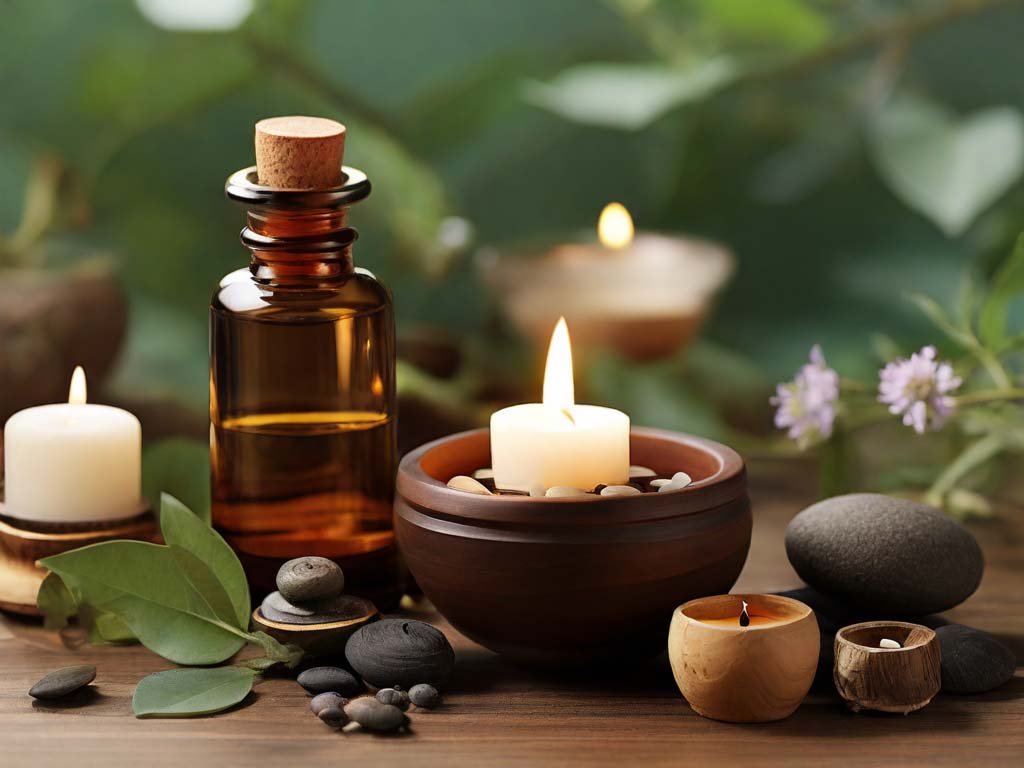
Aromatherapy for Kapha Imbalance: Ignite 4 Harmonizing Earth and Water Energies
Prelude:
In Ayurveda, Kapha represents the earth and water elements, governing qualities of stability, nurturing, and endurance. When Kapha becomes imbalanced, individuals may experience lethargy, congestion, and emotional stagnation. Aromatherapy offers natural remedies to harmonize Kapha dosha, promoting vitality and balance. This article explores techniques, DIY aromatherapy for Kapha imbalance recipes, and the importance of incorporating these practices into daily life for holistic well-being.
Understanding Kapha Imbalance:
Aromatherapy for Kapha imbalance, a common occurrence in Ayurvedic practice, manifests in a variety of symptoms that impact both physical and emotional well-being. One prominent sign of Kapha imbalance is sluggishness, characterized by a lack of energy and motivation. Individuals experiencing Kapha dominance may find themselves feeling lethargic and unmotivated, struggling to find the drive to engage in daily activities.
Weight gain is another common manifestation of Kapha imbalance. Kapha dosha governs qualities of heaviness and stability, and when this dosha becomes aggravated, individuals may experience an increase in weight, particularly around the abdomen. Factors such as a sedentary lifestyle and excessive consumption of heavy, oily, and sweet foods can contribute to this weight gain, exacerbating Kapha imbalance.
Respiratory issues are also prevalent among those with Kapha dominance. Excess Kapha in the body can lead to congestion and mucus accumulation in the respiratory tract, resulting in conditions such as colds, allergies, and sinus infections. Damp environments further exacerbate these respiratory issues, making individuals more susceptible to respiratory ailments.
Fortunately, aromatherapy offers a gentle yet effective approach to addressing these symptoms and restoring balance to Kapha dosha. Essential oils possess unique therapeutic properties that can help alleviate feelings of stagnation and heaviness while promoting vitality and balance. Invigorating oils such as eucalyptus, peppermint, and rosemary can help stimulate the senses, promote circulation, and clear congestion in the respiratory tract, offering relief from Kapha-related respiratory issues.
Moreover, incorporating aromatherapy for Kapha imbalance into daily life provides individuals with a natural and holistic way to support their overall well-being. By utilizing aromatherapeutic techniques such as inhalation, massage, and room spraying, individuals can harness the healing power of nature to balance their Kapha energy, promote
Techniques for Harmonizing Kapha with Aromatherapy:
- Invigorating Body Scrub:
- Ingredients:
- 1 cup of sea salt or sugar
- 3 tablespoons of coconut oil
- 5 drops of eucalyptus essential oil
- 3 drops of grapefruit essential oil
- Directions:
- Mix the sea salt or sugar with coconut oil in a bowl.
- Add eucalyptus and grapefruit essential oils and stir well.
- Use the body scrub in the shower to invigorate the senses and promote circulation, helping to alleviate Kapha-related lethargy and congestion.
- Ingredients:
- Stimulating Inhalation Blend:
- Ingredients:
- 3 drops of rosemary essential oil
- 3 drops of peppermint essential oil
- 2 drops of lemon essential oil
- Directions:
- Add the rosemary, peppermint, and lemon essential oils to a bowl of hot water.
- Cover your head with a towel and inhale deeply for a few minutes to stimulate the respiratory system and uplift Kapha-related stagnation.
- Ingredients:
- Energizing Room Spray:
- Ingredients:
- 2 ounces of distilled water
- 1 tablespoon of witch hazel
- 10 drops of bergamot essential oil
- 7 drops of ginger essential oil
- Directions:
- Mix the distilled water with witch hazel in a spray bottle.
- Add bergamot and ginger essential oils and shake well.
- Use the room spray to create a refreshing atmosphere and dispel Kapha-related heaviness and lethargy.
- Ingredients:
- Kapha-Balancing Massage Oil:
- Ingredients:
- 2 tablespoons of almond oil
- 5 drops of juniper essential oil
- 3 drops of rosemary essential oil
- Directions:
- Combine almond oil with juniper and rosemary essential oils in a small container.
- Massage the oil onto the body, focusing on areas of stiffness and congestion, to promote circulation and invigorate Kapha-related sluggishness.
- Ingredients:
Why Incorporate These Techniques into Daily Life?
Incorporating aromatherapy for Kapha imbalance techniques for harmonizing Kapha into daily life offers a multitude of benefits that contribute to overall well-being. These practices serve as powerful tools for invigorating the senses, promoting circulation, and uplifting the mood, making them essential for combating the lethargy and congestion often associated with Kapha imbalance.
By integrating aromatherapy for Kapha imbalance into daily self-care routines such as showering, inhalation, and room spraying, individuals can cultivate a greater sense of vitality, clarity, and well-being. For instance, starting the day with an invigorating shower using a Kapha-balancing body scrub can help awaken the senses and provide a much-needed energy boost to kickstart the day. The uplifting aroma of essential oils such as eucalyptus and grapefruit can help dispel feelings of heaviness and stagnation, promoting a sense of freshness and vitality.
Inhalation of stimulating essential oil blends throughout the day can also provide a quick and effective way to combat lethargy and improve mental clarity. Aromatherapy inhalation can be as simple as adding a few drops of essential oil to a tissue or inhaler and taking deep breaths whenever needed. The refreshing scents of oils like peppermint and lemon can help awaken the mind, increase focus, and promote a sense of alertness and vitality.
Additionally, incorporating aromatherapy for Kapha imbalance room sprays into the home or workspace can help create an uplifting and energizing environment conducive to productivity and well-being. A quick spritz of a Kapha-balancing room spray can help dispel feelings of heaviness and create a sense of freshness and vitality in the air, promoting a positive mood and enhancing overall energy levels.
Overall, integrating aromatherapy for Kapha imbalance techniques for harmonizing Kapha into daily life offers a holistic approach to well-being that addresses both physical and emotional imbalances. By embracing these practices with intention and consistency, individuals can cultivate a greater sense of vitality, clarity, and well-being, leading to a more balanced and fulfilling life.
The Upshot:
Harmonizing Kapha with aromatherapy provides a natural and holistic approach to promoting well-being on physical, mental, and emotional levels. By incorporating techniques such as body scrubs, inhalation blends, room sprays, and massage oils into daily life, individuals can nurture their Kapha dosha and cultivate a deeper sense of vitality and balance. Embrace the power of aromatherapy to invigorate the senses, promote circulation, and uplift the spirit, enhancing your journey towards optimal health and vitality with aromatherapy for Kapha imbalance.
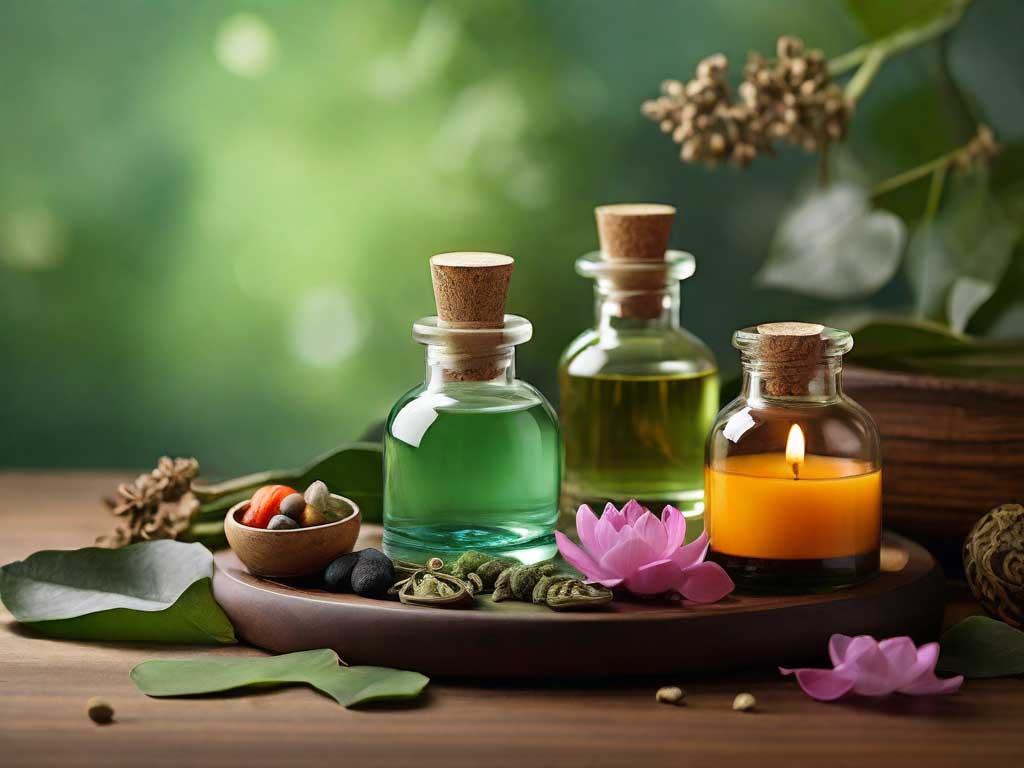
Synergizing Serenity: Empowering 3 Ayurveda Aromatherapy for Holistic Wellness
In the vast tapestry of holistic healing modalities, Ayurveda stands as a timeless beacon of wisdom, offering profound insights into the interconnectedness of mind, body, and spirit. Rooted in the ancient traditions of India, ayurveda aromatherapy for holistic wellness encompasses a comprehensive system of medicine that celebrates the innate intelligence of the body and its ability to heal itself when in balance.
Unlocking the Wisdom of Ayurveda aromatherapy for holistic wellness
At the core of Ayurveda lies a profound respect for the natural world and its innate intelligence. This ancient healing system recognizes that we are intricately connected to the rhythms of nature, and that our well-being is deeply influenced by the elements and energies that surround us.
Central to the philosophy of Ayurveda are the three doshas—Vata, Pitta, and Kapha. These doshas are dynamic forces that govern all aspects of our being, from our physical constitution to our mental and emotional tendencies. Understanding the unique qualities of each dosha is essential for achieving balance and harmony in our lives.
Vata, characterized by the elements of air and ether, is associated with movement and change. It governs functions such as circulation, respiration, and communication. When Vata is in balance, we experience creativity, adaptability, and a sense of lightness. However, when Vata becomes aggravated, we may experience anxiety, restlessness, and digestive issues.
Pitta, fueled by fire and water, governs metabolism, digestion, and transformation. It is responsible for our intellect, ambition, and determination. When Pitta is in balance, we are focused, driven, and able to digest information and experiences effectively. Yet, an excess of Pitta can lead to inflammation, irritability, and digestive disorders.
Kapha, grounded in earth and water, provides stability, strength, and endurance. It governs structure and lubrication in the body, as well as our emotional resilience and capacity for nurturing. When Kapha is balanced, we feel grounded, calm, and compassionate. However, an imbalance in Kapha can manifest as lethargy, weight gain, and emotional stagnation.
In Ayurvedic medicine, the goal is to maintain harmony among the doshas, allowing each to express its unique qualities in a balanced way. Through lifestyle practices, dietary choices, and therapeutic treatments, individuals can work to restore equilibrium and promote overall health and well-being.
By understanding the doshas and their influence on our lives, we can cultivate greater awareness and appreciation for the interconnectedness of all things. ayurveda aromatherapy for holistic wellness invites us to align with the rhythms of nature, honoring the wisdom of the doshas as we strive to live in harmony with ourselves and the world around us.
Aromatherapy: Nature’s Healing Symphony
Ayurveda aromatherapy for holistic wellness, often regarded as nature’s healing symphony, intertwines seamlessly with the principles of Ayurveda to offer a holistic approach to well-being. Through the artful utilization of aromatic plant essences, Ayurvedic Aromatherapy endeavors to rebalance the doshas, alleviate disharmonies, and elevate vitality across physical, mental, and emotional realms.
DIY Aromatherapy Recipes for Balance
1. Vata-Soothing Massage Oil:
- Ingredients: Sesame oil, Lavender essential oil, Geranium essential oil.
- Directions: Combine 2 tablespoons of sesame oil with 5 drops of Lavender oil and 3 drops of Geranium oil. Warm the mixture gently and massage onto the skin for a grounding and deeply relaxing experience. Ideal for calming Vata’s airy nature and promoting a sense of stability and tranquility.
2. Pitta-Cooling Facial Mist:
- Ingredients: Rose water, Sandalwood essential oil, Peppermint essential oil.
- Directions: Mix 2 ounces of rose water with 3 drops of Sandalwood oil and 2 drops of Peppermint oil. Transfer the blend into a spray bottle and spritz onto the face for an instantly refreshing and soothing sensation. This cooling mist helps pacify Pitta’s fiery energy, reducing inflammation and restoring balance to the skin and mind.
3. Kapha-Revitalizing Room Spray:
- Ingredients: Distilled water, Lemon essential oil, Eucalyptus essential oil.
- Directions: Blend 2 ounces of distilled water with 5 drops of Lemon oil and 3 drops of Eucalyptus oil. Pour the mixture into a spray bottle and use it to refresh your living space. This invigorating room spray helps uplift and stimulate Kapha’s grounded energy, promoting clarity, motivation, and a revitalized atmosphere.
Embracing the Healing Power of Aromatherapy
These DIY ayurveda aromatherapy for holistic wellness recipes offer simple yet effective ways to incorporate the therapeutic benefits of essential oils into your daily routine. Whether you seek relaxation, rejuvenation, or a renewed sense of vitality, Ayurvedic Aromatherapy provides a gentle and natural path to holistic well-being.
By harmonizing the doshas through the judicious use of aromatic plant essences, we can tap into the profound healing intelligence of nature and restore balance to our lives. Embrace the aromatic symphony of ayurveda aromatherapy for holistic wellness and embark on a journey of self-discovery, transformation, and radiant health.
Embracing Holistic Wellness
As we journey deeper into the realms of ayurveda aromatherapy for holistic wellness, we come to realize that true healing is not merely the absence of disease but the cultivation of harmony and vitality in every aspect of our lives. Through mindful self-care practices, nourishing dietary choices, and the therapeutic use of aromatic essences, we can awaken the innate healing intelligence that resides within each of us.
In the fragrant embrace of ayurveda aromatherapy for holistic wellness, we find a sanctuary—a place where the wisdom of the ancients merges with the beauty of the present moment, guiding us towards a future filled with vitality, balance, and joy. Let us embark on this journey together, honouring the wisdom of Ayurveda and the healing power of nature’s aromatic treasures.
As we embrace the holistic path to wellness, may we walk in harmony with the rhythms of the earth, honouring the interconnectedness of all life and celebrating the infinite potential for healing that resides within each of us. Together, let us nurture the seeds of balance, cultivate the fruits of vitality, and blossom into the radiant beings we are meant to be.
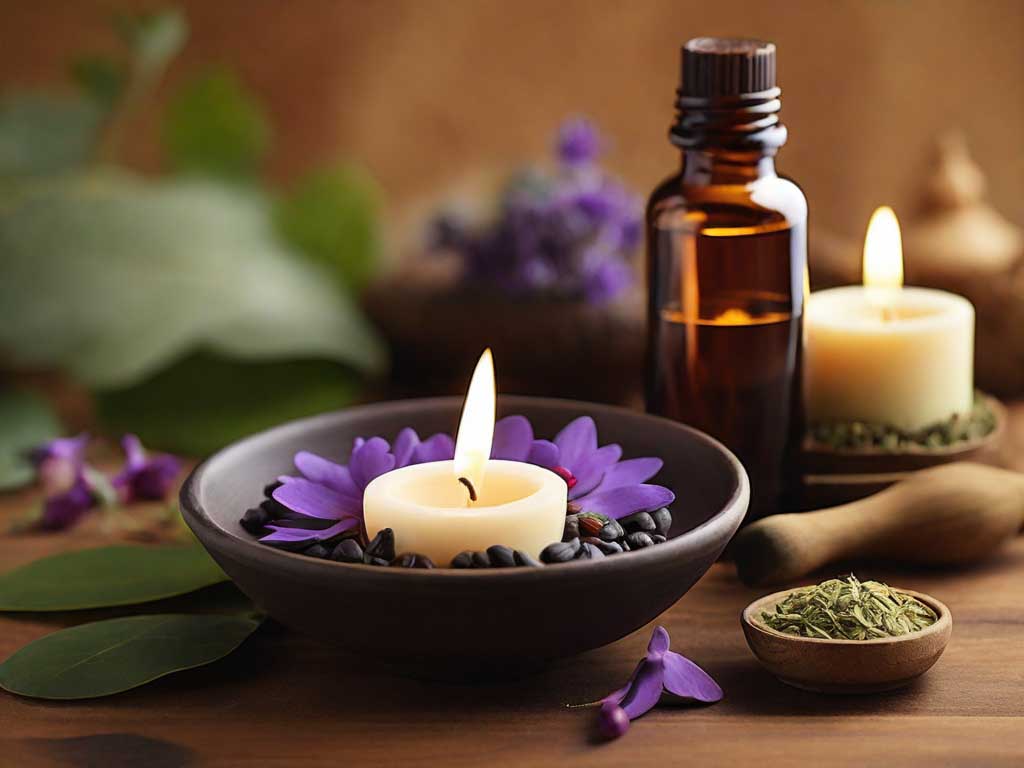
Pitta Pacifying With Aromatherapy Techniques: Cooling the Fire Element with Aromatherapy in Ayurveda for Optimal Balance and Wellness – 4 Essential Tips
Prelude:
In Ayurveda, Pitta represents the fire and water elements, governing qualities of intensity, ambition, and transformation. When Pitta becomes imbalanced, individuals may experience irritability, inflammation, and digestive issues. Aromatherapy offers natural remedies to pacify Pitta dosha, promoting a sense of calm and balance. This article explores pitta pacifying with aromatherapy techniques, DIY recipes, and the importance of incorporating these practices into daily life for holistic well-being.
Understanding Pitta Imbalance:
Pitta imbalance, a common occurrence in Ayurvedic practice, manifests in various forms, often affecting both physical and emotional well-being. Skin irritations, ranging from rashes to acne, are typical indications of Pitta aggravation. The skin, being the largest organ of the body, reflects imbalances within, and Pitta’s fiery nature can lead to inflammation and sensitivity, exacerbating conditions such as eczema and psoriasis.
Additionally, Pitta imbalance frequently manifests in digestive disturbances, notably acid reflux. Pitta governs the digestive fire, responsible for metabolizing food and ensuring proper assimilation of nutrients. When Pitta is heightened, excessive heat can accumulate in the digestive tract, leading to acid reflux, heartburn, and other gastrointestinal issues. This discomfort not only affects physical health but also contributes to emotional instability, as chronic digestive issues can disrupt one’s overall sense of well-being.
Moreover, Pitta imbalance can manifest as heightened feelings of anger, irritability, and frustration. Pitta’s fiery energy, when imbalanced, can result in emotional volatility and impatience. Stress, a common trigger for Pitta aggravation, further exacerbates these emotional imbalances, creating a cycle of tension and irritability.
Fortunately, pitta pacifying with aromatherapy techniques offers a gentle yet effective approach to address these symptoms and restore balance to Pitta dosha. Essential oils possess unique therapeutic properties that can help pacify Pitta’s fiery nature and promote a sense of calm and equilibrium. Cooling oils such as peppermint, chamomile, and lavender can soothe inflammation, both externally and internally, providing relief from skin irritations and digestive discomfort.
Moreover, aromatherapy has a profound impact on emotional well-being, helping to alleviate feelings of anger and irritability. Calming essential oils such as sandalwood, rose, and neroli can soothe the nervous system, promoting emotional balance and resilience in the face of stress and tension.
By incorporating pitta pacifying with aromatherapy techniques into their daily routines, individuals can harness the healing power of nature to restore balance to Pitta dosha, promoting both physical and emotional well-being. Whether through massage, inhalation, or topical application, aromatherapy offers a holistic approach to addressing Pitta imbalance and supporting overall health and vitality.
Pitta Pacifying with aromatherapy Techniques:
- Cooling Body Oil:
- Ingredients:
- 2 tablespoons of coconut oil
- 5 drops of rose essential oil
- 3 drops of jasmine essential oil
- Directions:
- Mix the coconut oil with rose and jasmine essential oils in a small container.
- Massage the oil onto your body, focusing on areas of heat and inflammation.
- Use this cooling body oil daily to soothe Pitta-related skin irritations and promote relaxation.
- Ingredients:
- Pitta-Balancing Bath Blend:
- Ingredients:
- 1 cup of sea salt
- 5 drops of peppermint essential oil
- 3 drops of chamomile essential oil
- Directions:
- Combine the sea salt with peppermint and chamomile essential oils in a bowl.
- Add the bath blend to warm bathwater and soak for 20 minutes to cool and calm Pitta-related irritations and tension.
- Ingredients:
- Aromatic Room Spray:
- Ingredients:
- 2 ounces of distilled water
- 1 tablespoon of witch hazel
- 10 drops of lavender essential oil
- 7 drops of sandalwood essential oil
- Directions:
- Mix the distilled water with witch hazel in a spray bottle.
- Add lavender and sandalwood essential oils to the bottle and shake well.
- Use the aromatic spray to create a calming atmosphere and alleviate Pitta-related stress and irritability.
- Ingredients:
- Pitta-Soothing Roll-On:
- Ingredients:
- 1 tablespoon of almond oil
- 3 drops of peppermint essential oil
- 3 drops of vetiver essential oil
- 2 drops of neroli essential oil
- Directions:
- Combine almond oil with peppermint, vetiver, and neroli essential oils in a roll-on bottle.
- Apply the roll-on to pulse points such as wrists and temples to cool Pitta-related tension and promote emotional balance.
- Ingredients:
Why Incorporate These Techniques into Daily Life?
Incorporating pitta pacifying with aromatherapy techniques into daily life offers a myriad of benefits that extend beyond mere symptom relief. By embracing these practices as part of a holistic self-care regimen, individuals can experience profound transformations in their overall well-being, both physically and emotionally.
Firstly, these techniques provide effective relief from symptoms associated with Pitta imbalance, such as inflammation and irritability. Aromatherapeutic oils possess unique properties that help to cool the fiery nature of Pitta, soothing skin irritations, calming digestive discomfort, and alleviating emotional tension. By addressing these symptoms at their root, aromatherapy offers holistic support for individuals seeking relief from Pitta-related discomforts.
Moreover, incorporating aromatherapy into daily life promotes emotional balance and resilience, making it an invaluable tool for managing stress and promoting relaxation. The soothing aromas of essential oils have a direct impact on the limbic system, the part of the brain responsible for emotions and memory. By inhaling these calming scents, individuals can reduce feelings of anxiety, tension, and irritability, fostering a greater sense of inner peace and well-being.
Furthermore, integrating aromatherapy into daily self-care routines such as massage, bathing, and room sprays encourages mindfulness and presence in the present moment. These practices offer opportunities for individuals to cultivate a deeper connection with their bodies, minds, and emotions, fostering a greater sense of self-awareness and self-love. By prioritizing their well-being through regular aromatherapy rituals, individuals can nurture a positive relationship with themselves and cultivate a greater sense of calm, resilience, and vitality in their daily lives.
In essence, incorporating pitta pacifying with aromatherapy techniques into daily life offers a holistic approach to well-being that addresses the root causes of imbalance while promoting relaxation, emotional balance, and self-awareness. By embracing these practices with intention and mindfulness, individuals can cultivate a greater sense of harmony and vitality in their lives, leading to a more fulfilling and balanced existence.
Conclusion:
Pitta pacifying with aromatherapy techniques provides a natural and holistic approach to promoting well-being on physical, mental, and emotional levels. By incorporating techniques such as body oils, bath blends, room sprays, and roll-ons into daily life, individuals can nurture their Pitta dosha and cultivate a deeper sense of calm, balance, and harmony. Embrace the power of aromatherapy to cool the fire of Pitta energy and enhance your journey towards optimal health and vitality.
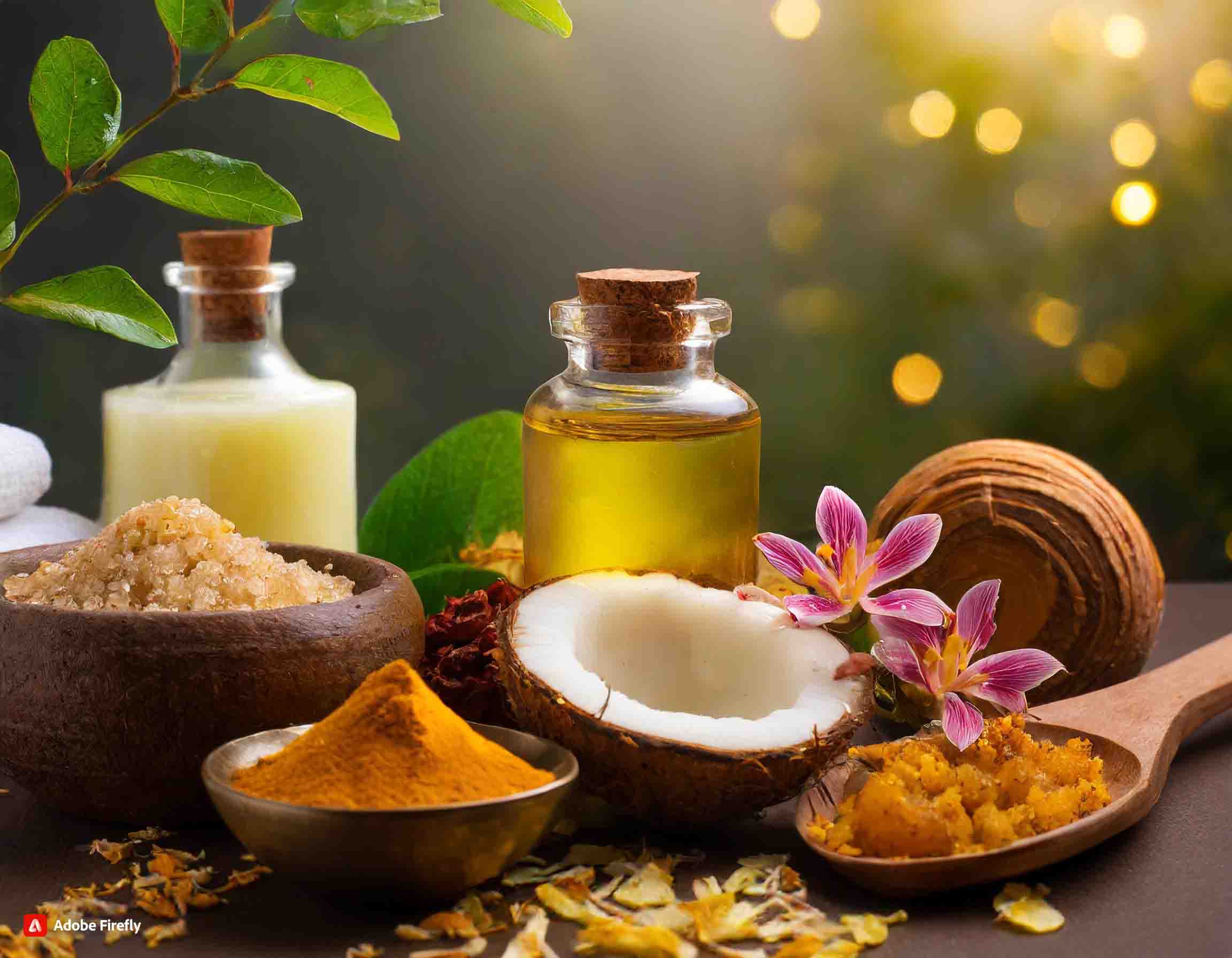
Ayurvedic Skincare with Essential Oils: 4 Unlocking Natural Remedies for Glowing Skin
Introduction:
Ayurvedic skincare with essential oils presents a comprehensive method for attaining radiant and healthy skin, grounded in ancient wisdom. Ayurveda, an ancient Indian healing system, underscores the significance of balance and harmony in sustaining skin vitality. This approach acknowledges that external beauty reflects inner well-being, emphasizing holistic practices to nurture both. The benefits of Ayurvedic skincare extend beyond mere cosmetic enhancement, offering a deeper connection to nature and oneself.
By harnessing the therapeutic properties of essential oils, Ayurvedic skincare addresses various skin concerns effectively. From soothing inflammation to promoting cellular rejuvenation, these oils offer a natural solution to common skin issues. DIY recipes incorporating these oils allow for personalized skincare tailored to individual needs. Moreover, integrating Ayurvedic principles into daily routines fosters mindfulness and self-care, enhancing overall well-being.
Incorporating Ayurvedic skincare techniques into daily life is vital for achieving and maintaining glowing skin. By honouring the body’s innate intelligence and harmonizing with nature’s rhythms, Ayurveda guides individuals towards radiant skin and holistic wellness.
The Benefits of Ayurvedic Skincare with Essential Oils:
Ayurvedic skincare with essential oils offers a multifaceted approach to nurturing the skin, rooted in the principles of balance and vitality. Central to Ayurveda is the belief that true beauty emanates from within, emphasizing the importance of holistic practices to maintain skin health. Essential oils, extracted from plants and herbs, play a pivotal role in this skincare regimen, boasting a myriad of therapeutic benefits.
One of the key advantages of essential oils in Ayurvedic skincare is their ability to deeply nourish the skin. These oils possess unique molecular structures that enable them to penetrate the skin’s layers effectively, delivering essential nutrients and hydration where it’s needed most. Whether it’s moisturizing dry skin or regulating sebum production in oily skin, essential oils work harmoniously to restore balance and vitality.
Furthermore, essential oils offer potent antioxidant and anti-inflammatory properties, protecting the skin from environmental stressors and promoting cellular repair and regeneration. This not only helps to combat signs of aging but also supports overall skin health and resilience.
In addition to their physical benefits, essential oils exert powerful aromatherapeutic effects that can positively impact mental and emotional well-being. By promoting relaxation, reducing stress, and uplifting the mood, these oils contribute to a holistic approach to skincare that addresses both the body and mind.
Incorporating Ayurvedic skincare with essential oils into your daily routine offers a holistic approach to achieving and maintaining radiant skin. By harnessing the healing power of nature, this ancient practice provides a nurturing and rejuvenating experience that goes beyond surface-level beauty, promoting balance, vitality, and overall well-being.
DIY Recipes for Ayurvedic Skincare:
- Rejuvenating Facial Serum:
- Ingredients:
- 1 tablespoon of jojoba oil
- 3 drops of rosehip oil
- 2 drops of lavender essential oil
- Directions:
- Mix the jojoba oil with rosehip oil in a small dropper bottle.
- Add the lavender essential oil and shake well.
- Apply a few drops to clean, damp skin morning and night to hydrate and rejuvenate the skin.
- Ingredients:
- Soothing Facial Steam:
- Ingredients:
- 2 cups of hot water
- 3 drops of chamomile essential oil
- 2 drops of geranium essential oil
- Directions:
- Pour the hot water into a bowl and add the chamomile and geranium essential oils.
- Lean over the bowl with a towel over your head and steam your face for 5-10 minutes to open pores and promote relaxation.
- Ingredients:
- Clarifying Clay Mask:
- Ingredients:
- 1 tablespoon of bentonite clay
- 1 teaspoon of honey
- 2 drops of tea tree essential oil
- Directions:
- Mix the bentonite clay with honey and tea tree essential oil in a small bowl.
- Apply the mask to clean, dry skin and leave on for 10-15 minutes before rinsing off with warm water to purify and clarify the skin.
- Ingredients:
- Hydrating Body Oil:
- Ingredients:
- 1/4 cup of coconut oil
- 5 drops of jasmine essential oil
- 3 drops of sandalwood essential oil
- Directions:
- Melt the coconut oil in a double boiler and let it cool slightly.
- Add the jasmine and sandalwood essential oils and mix well.
- Apply the oil to damp skin after showering to lock in moisture and promote soft, supple skin.
- Ingredients:
Why Incorporate These Techniques into Daily Life:
Integrating Ayurvedic skincare techniques with essential oils into daily life is paramount for sustaining skin health and achieving a luminous complexion. These ancient remedies offer a holistic approach to skincare, enriching the skin with a plethora of nutrients essential for its vitality and radiance. Vitamins, antioxidants, and fatty acids present in these natural ingredients work synergistically to nourish the skin, stimulate cellular regeneration, and bolster collagen production. This not only helps to maintain skin elasticity and firmness but also aids in combating signs of aging, such as fine lines and wrinkles.
Moreover, the aromatherapeutic properties of essential oils play a pivotal role in promoting skin health and overall well-being. Stress is a significant contributing factor to various skin issues, including acne and premature aging. By incorporating essential oils into daily skincare routines, individuals can harness their calming and stress-relieving effects to mitigate these concerns. Reduced stress levels not only improve skin condition but also enhance mental clarity and emotional balance.
Furthermore, establishing a consistent skincare regimen rooted in Ayurvedic principles fosters a deeper connection with oneself and nature. By prioritizing self-care rituals that honor the body’s innate wisdom, individuals cultivate a sense of mindfulness and self-love, which radiates outwardly as healthy, glowing skin.
In essence, incorporating Ayurvedic skincare techniques with essential oils into daily life is not merely about surface-level beauty but rather a holistic approach to nurturing both the skin and the spirit. By embracing these ancient practices, individuals can achieve lasting results that transcend cosmetic enhancement, leading to radiant skin and enhanced overall well-being.
Conclusion:
In conclusion, Ayurvedic skincare with essential oils presents a holistic and potent method for attaining radiant and healthy skin. Through the harmonious blend of botanical extracts and aromatherapeutic benefits, individuals can nurture their skin while fostering inner balance and well-being. This ancient practice offers a natural and effective alternative to conventional skincare, harnessing the power of nature’s bounty to nourish, protect, and rejuvenate the skin.
With an array of DIY recipes readily available for facial serums, steams, masks, and body oils, incorporating Ayurvedic skincare techniques into daily life is both accessible and gratifying. These simple yet profound rituals provide a tangible connection to the wisdom of Ayurveda, empowering individuals to take control of their skincare routines and embrace self-care as a sacred ritual.
By embracing Ayurvedic skincare with essential oils, individuals can unlock the secret to glowing skin while simultaneously promoting relaxation and reducing stress. It’s not just about achieving external beauty; it’s about nurturing the skin from within and honouring the body’s innate wisdom. Embrace the transformative power of Ayurveda and essential oils to unveil the radiance of your skin and enhance your overall well-being.
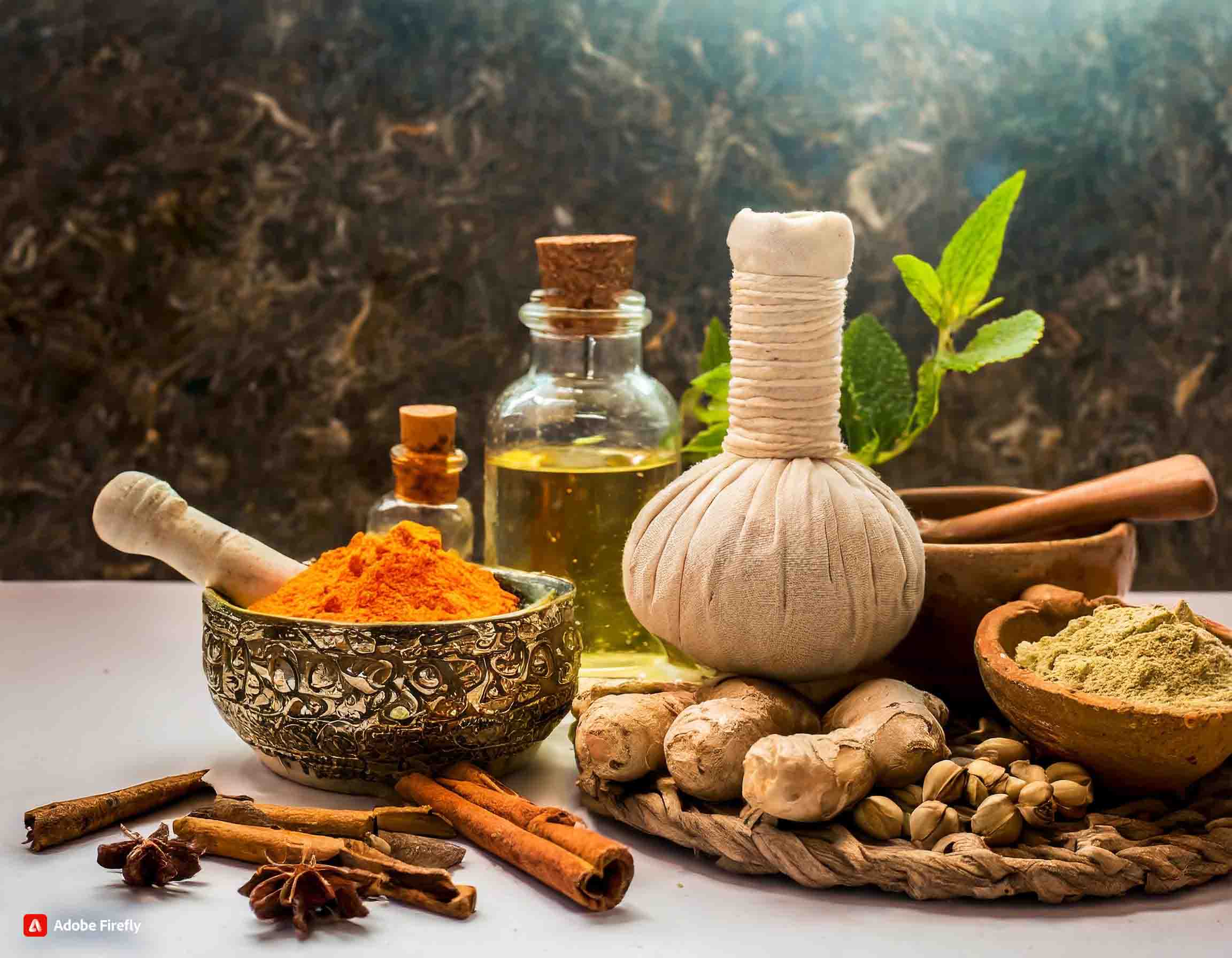
Revitalize with 4 Secret Aromatherapy for Digestive Health in Ayurveda: Nurturing Agni, the Digestive Fire”
Introduction:
Delving into the realm of Ayurveda, aromatherapy emerges as a potent ally in nurturing digestive health. Esteemed for its profound insights, Ayurveda underscores the pivotal role of maintaining robust digestive fire, known as Agni, to promote holistic well-being. This article embarks on a journey through the therapeutic benefits of aromatherapy for digestive health, illuminating its transformative potential deeply ingrained in ancient healing practices.
Aromatherapy for digestive health offers a harmonious blend of sensory delight and therapeutic efficacy. From soothing essential oil blends to invigorating herbal infusions, these aromatic remedies work synergistically to support optimal digestion. DIY recipes featured within this exploration empower individuals to craft personalized blends tailored to their unique needs, fostering a deeper connection with both body and mind.
Incorporating aromatherapy techniques into daily rituals becomes paramount for maintaining digestive equilibrium. By harnessing the power of scent, individuals can embark on a holistic journey towards digestive wellness, unlocking the inherent wisdom of Ayurveda in the process. Elevate your well-being and embrace the transformative potential of aromatherapy for digestive health, enriching your life with vitality and balance.
The Importance of Agni in Ayurveda:
In the intricate tapestry of Ayurveda, Agni emerges as the cornerstone of health, wielding unparalleled influence over digestion, metabolism, and nutrient assimilation. Revered as the sacred fire within, Agni orchestrates the intricate dance of transformation within the body, converting ingested food into essential nutrients and energy. Its vitality extends beyond mere digestion, permeating every aspect of bodily function and vitality.
Agni, when robust and balanced, operates as a well-oiled machine, efficiently breaking down food, expelling toxins, and generating vital energy, known as prana. This vital force sustains life, fostering vitality and resilience in the physical and energetic realms. However, the delicate balance of Agni can be disrupted by a myriad of modern-day stressors, including chronic stress, erratic eating habits, and exposure to environmental pollutants.
When Agni falters, its repercussions reverberate throughout the body, manifesting as a spectrum of digestive woes. Indigestion, bloating, and constipation serve as glaring indicators of Agni’s weakened state, signaling an urgent need for restoration and balance. In the quest for digestive harmony, Ayurveda offers a multifaceted approach, harnessing the therapeutic power of aromatherapy to rekindle Agni’s flame.
Aromatherapy for digestive health emerges as a gentle yet potent tool in Ayurveda’s arsenal, offering aromatic remedies to fortify and invigorate Agni. Essential oils infused with digestive-friendly properties, such as ginger, peppermint, and fennel, work synergistically to soothe digestive discomfort and ignite Agni’s fervor. Whether through aromatic massage oils, herbal teas, or inhalation blends, aromatherapy infuses daily rituals with healing intent, nurturing Agni back to its optimal state of vitality.
In embracing the profound connection between scent and digestion, individuals embark on a transformative journey towards digestive wellness. By incorporating aromatherapy into their holistic regimen, they honor the sacred flame of Agni, restoring balance and vitality to body, mind, and spirit.
Aromatherapy for Digestive Health:
Aromatherapy utilizes the therapeutic properties of essential oils to support digestion and balance Agni. Certain essential oils have carminative, digestive, and anti-inflammatory properties that help soothe digestive discomfort and promote optimal digestion. By incorporating aromatherapy into daily routines, individuals can support their digestive health naturally and holistically.
DIY Recipes for Digestive Support:
- Digestive Massage Oil:
- Ingredients:
- 1/4 cup of sesame oil
- 5 drops of ginger essential oil
- 3 drops of peppermint essential oil
- Directions:
- Mix the sesame oil with ginger and peppermint essential oils in a small bottle.
- Massage the oil onto the abdomen in a clockwise direction to stimulate digestion and relieve bloating.
- Ingredients:
- Digestive Inhalation Blend:
- Ingredients:
- 3 drops of fennel essential oil
- 3 drops of cardamom essential oil
- 2 drops of lemon essential oil
- Directions:
- Add the fennel, cardamom, and lemon essential oils to a bowl of hot water.
- Cover your head with a towel and inhale deeply for 5-10 minutes to ease digestive discomfort and promote relaxation.
- Ingredients:
- Digestive Tea Infusion:
- Ingredients:
- 1 cup of hot water
- 1 teaspoon of fennel seeds
- 1 teaspoon of coriander seeds
- 1 teaspoon of cumin seeds
- Directions:
- Steep the fennel, coriander, and cumin seeds in hot water for 10 minutes.
- Strain the tea and sip slowly to support digestion and relieve gas and bloating.
- Ingredients:
- Digestive Room Spray:
- Ingredients:
- 2 ounces of distilled water
- 1 tablespoon of witch hazel
- 10 drops of lavender essential oil
- 5 drops of chamomile essential oil
- Directions:
- Mix the distilled water with witch hazel in a spray bottle.
- Add the lavender and chamomile essential oils and shake well.
- Spray the room to create a calming atmosphere and promote relaxation during meals.
- Ingredients:
Why Incorporate These Techniques into Daily Life:
Integrating aromatherapy for digestive health into daily routines unveils a treasure trove of benefits that transcend mere physical wellness, fostering a harmonious alignment of body, mind, and spirit. These aromatic practices serve as gentle yet potent allies in the quest for holistic well-being, offering a myriad of therapeutic effects that nurture and support digestive vitality.
Aromatherapy techniques, ranging from soothing massages to invigorating inhalations and comforting tea infusions, provide multifaceted avenues to soothe digestive discomfort and kindle Agni’s flame. Through the artful application of essential oils infused with digestive-friendly properties like ginger, peppermint, and chamomile, individuals can alleviate bloating, indigestion, and other digestive woes, promoting a sense of ease and comfort within.
Moreover, the ritualistic incorporation of aromatherapy into daily life fosters mindfulness and intentionality, inviting individuals to cultivate a deeper connection with their bodies and the natural world. Each inhalation, each gentle massage, becomes a sacred act of self-care, honouring the innate wisdom of the body and its capacity for healing and renewal.
By embracing aromatherapy for digestive health as a cornerstone of their holistic regimen, individuals empower themselves to reclaim ownership of their well-being. Through these aromatic practices, they forge a path towards radiant health and vitality, where balance and harmony reign supreme, and the sacred flame of Agni burns brightly within.
Conclusion:
Aromatherapy for digestive health is a gentle yet effective way to support Agni, the digestive fire, and promote optimal digestion. By utilizing essential oils and DIY recipes, individuals can soothe digestive discomfort, relieve bloating, and maintain overall digestive health. Incorporating these techniques into daily life not only supports physical well-being but also nurtures a harmonious connection between body, mind, and spirit in alignment with the principles of Ayurveda.
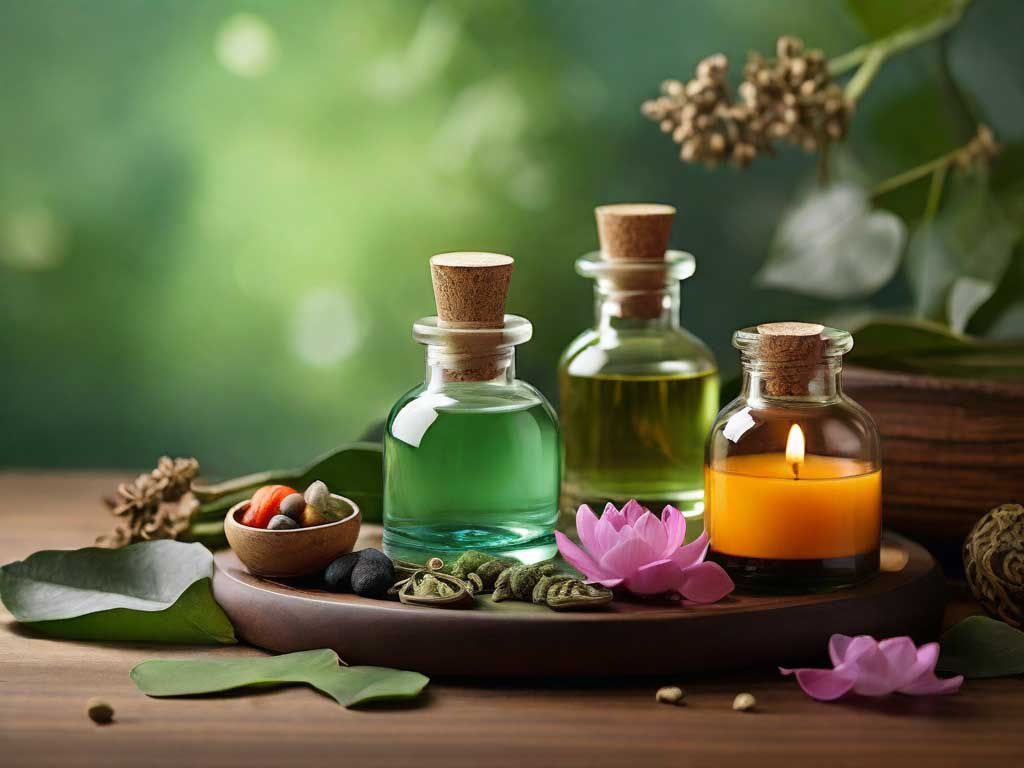
Ayurveda Aromatherapy Holistic Wellness Nurturing Harmony: Understanding Ayurveda and Embracing Aromatherapy for 5x Power”
In the vast tapestry of ayurveda aromatherapy holistic wellness and holistic healing modalities, Ayurveda stands as a timeless beacon of wisdom, offering profound insights into the interconnectedness of mind, body, and spirit. Rooted in the ancient traditions of India, Ayurveda encompasses a comprehensive system of medicine that celebrates the innate intelligence of the body and its ability to heal itself when in balance.
Unlocking the Wisdom of Ayurveda
At the core of Ayurveda lies a profound respect for the natural world and its innate intelligence. This ancient healing system recognizes that we are intricately connected to the rhythms of nature, and that our well-being is deeply influenced by the elements and energies that surround us.
Central to the philosophy of Ayurveda are the three doshas—Vata, Pitta, and Kapha. These doshas are dynamic forces that govern all aspects of our being, from our physical constitution to our mental and emotional tendencies. Understanding the unique qualities of each dosha is essential for achieving balance and harmony in our lives.
Vata, characterized by the elements of air and ether, is associated with movement and change. It governs functions such as circulation, respiration, and communication. When Vata is in balance, we experience creativity, adaptability, and a sense of lightness. However, when Vata becomes aggravated, we may experience anxiety, restlessness, and digestive issues.
Pitta, fueled by fire and water, governs metabolism, digestion, and transformation. It is responsible for our intellect, ambition, and determination. When Pitta is in balance, we are focused, driven, and able to digest information and experiences effectively. Yet, an excess of Pitta can lead to inflammation, irritability, and digestive disorders.
Kapha, grounded in earth and water, provides stability, strength, and endurance. It governs structure and lubrication in the body, as well as our emotional resilience and capacity for nurturing. When Kapha is balanced, we feel grounded, calm, and compassionate. However, an imbalance in Kapha can manifest as lethargy, weight gain, and emotional stagnation.
In Ayurvedic medicine, the goal is to maintain harmony among the doshas, allowing each to express its unique qualities in a balanced way. Through lifestyle practices, dietary choices, and therapeutic treatments, individuals can work to restore equilibrium and promote overall health and well-being.
By understanding the doshas and their influence on our lives, we can cultivate greater awareness and appreciation for the interconnectedness of all things. Ayurveda invites us to align with the rhythms of nature, honoring the wisdom of the doshas as we strive to live in harmony with ourselves and the world around us.
Ayurveda Aromatherapy Holistic Wellness Aromatherapy, often regarded as nature’s healing symphony, intertwines seamlessly with the principles of Ayurveda to offer a holistic approach to well-being. Through the artful utilization of aromatic plant essences, Ayurvedic Aromatherapy endeavors to rebalance the doshas, alleviate disharmonies, and elevate vitality across physical, mental, and emotional realms.
Aromatherapy: Nature’s Healing Symphony
DIY Aromatherapy Recipes for Balance
1. Vata-Soothing Massage Oil:
- Ingredients: Sesame oil, Lavender essential oil, Geranium essential oil.
- Directions: Combine 2 tablespoons of sesame oil with 5 drops of Lavender oil and 3 drops of Geranium oil. Warm the mixture gently and massage onto the skin for a grounding and deeply relaxing experience. Ideal for calming Vata’s airy nature and promoting a sense of stability and tranquility.
2. Pitta-Cooling Facial Mist:
- Ingredients: Rose water, Sandalwood essential oil, Peppermint essential oil.
- Directions: Mix 2 ounces of rose water with 3 drops of Sandalwood oil and 2 drops of Peppermint oil. Transfer the blend into a spray bottle and spritz onto the face for an instantly refreshing and soothing sensation. This cooling mist helps pacify Pitta’s fiery energy, reducing inflammation and restoring balance to the skin and mind.
3. Kapha-Revitalizing Room Spray:
- Ingredients: Distilled water, Lemon essential oil, Eucalyptus essential oil.
- Directions: Blend 2 ounces of distilled water with 5 drops of Lemon oil and 3 drops of Eucalyptus oil. Pour the mixture into a spray bottle and use it to refresh your living space. This invigorating room spray helps uplift and stimulate Kapha’s grounded energy, promoting clarity, motivation, and a revitalized atmosphere.
Embracing the Healing Power of Aromatherapy
These ayurveda aromatherapy holistic wellness DIY aromatherapy recipes offer simple yet effective ways to incorporate the therapeutic benefits of essential oils into your daily routine. Whether you seek relaxation, rejuvenation, or a renewed sense of vitality, Ayurvedic Aromatherapy provides a gentle and natural path to holistic well-being.
By harmonizing the doshas through the judicious use of aromatic plant essences, we can tap into the profound healing intelligence of nature and restore balance to our lives. Embrace the aromatic symphony of Ayurvedic Aromatherapy and embark on a journey of self-discovery, transformation, and radiant health.
Top of Form
Embracing Holistic Wellness
As we journey deeper into the realms of Ayurveda and Aromatherapy, we come to realize that true healing is not merely the absence of disease but the cultivation of harmony and vitality in every aspect of our lives. Through mindful self-care practices, nourishing dietary choices, and the therapeutic use of aromatic essences, we can awaken the innate healing intelligence that resides within each of us.
In the fragrant embrace of ayurveda aromatherapy holistic wellness, we find a sanctuary—a place where the wisdom of the ancients merges with the beauty of the present moment, guiding us towards a future filled with vitality, balance, and joy. Let us embark on this journey together, honouring the wisdom of Ayurveda and the healing power of nature’s aromatic treasures.
As we embrace the holistic path to wellness, may we walk in harmony with the rhythms of the earth, honouring the interconnectedness of all life and celebrating the infinite potential for healing that resides within each of us. Together, let us nurture the seeds of balance, cultivate the fruits of vitality, and blossom into the radiant beings we are meant to be.
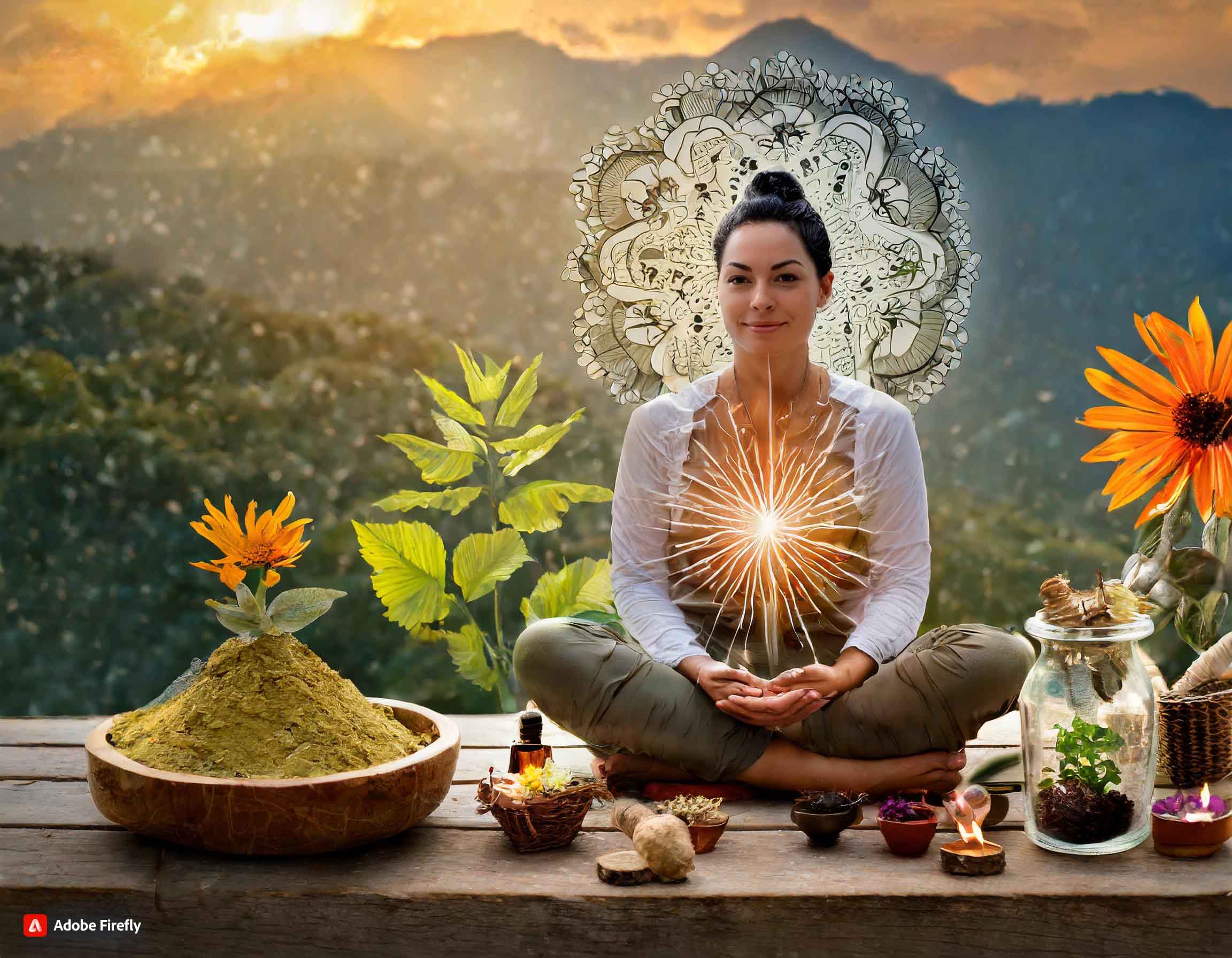
Aromas for Emotional Balance: Managing stress and uplifting mood with 4 Ayurvedic practices.
Introduction:
Aromas for emotional balance serve as integral agents in the delicate equilibrium of emotional well-being, wielding the power to shape mood and alleviate stress. Rooted in Ayurveda, the ancient healing system of India, aromatic practices are harnessed as profound tools for promoting mental harmony and overall well-being.
In the realm of Ayurveda, where mind-body balance is paramount, aromatherapy emerges as a therapeutic modality to foster emotional equilibrium. Essential oils, carefully derived from botanical sources, embody the essence of nature’s healing energies. This article explores the multifaceted benefits of aromas in nurturing emotional balance, unveiling the therapeutic potential embedded in these scents.
By delving into the realm of aromatherapy, individuals can access a wealth of benefits for their emotional well-being. The article unfolds the art of utilizing aromas to manage stress, uplift mood, and cultivate a sense of tranquility. Additionally, DIY recipes are unveiled, offering practical insights into incorporating aromatherapeutic practices into daily life. Through these intentional aromatic rituals, individuals can embark on a journey towards emotional harmony, discovering the profound impact of scents on the mind and soul. The importance of seamlessly integrating these techniques into daily life is underscored, emphasizing the transformative potential of aromas in nurturing emotional balance and overall mental well-being.
The Impact of Aromas for emotional balance and Emotional Well-being:
Aromas for emotional balance wield a profound influence on our emotional landscape, capable of eliciting a spectrum of feelings and perceptions. Through olfaction, scents interact with the limbic system, the brain’s emotional centre, triggering profound responses that transcend mere sensory experiences. Certain aromas possess therapeutic qualities, making them powerful allies in promoting emotional balance and well-being.
In the realm of aromatherapy, the synergy between scent and emotion is well-recognized and extensively utilized. Essential oils, derived from aromatic plants, harbour a plethora of bioactive compounds that exert direct effects on the brain, influencing neurotransmitter activity and hormonal balance. For instance, lavender essential oil, with its calming properties, has been shown to reduce anxiety and improve mood, while citrus oils like bergamot and lemon uplift spirits and promote feelings of joy and optimism.
Ayurveda, the ancient Indian system of medicine, embraces aromatherapy as a holistic approach to emotional healing. In Ayurvedic philosophy, emotional well-being is intimately connected to the balance of the doshas – Vata, Pitta, and Kapha – within the body. Aromatherapy is utilized to pacify aggravated doshas and restore equilibrium to the mind and spirit. For instance, grounding scents like sandalwood and vetiver are employed to calm Vata imbalances characterized by anxiety and restlessness, while cooling aromas like rose and jasmine soothe fiery Pitta energies prone to irritability and anger.
Moreover, aromatherapy serves as a conduit for self-awareness and introspection, fostering a deeper connection with one’s emotional landscape. Through mindful inhalation and intentional scent rituals, individuals can cultivate a greater sense of emotional resilience and inner harmony. Whether through diffusing essential oils, applying them topically, or incorporating them into self-care rituals, aromatherapy offers a holistic approach to emotional well-being, addressing imbalances in the mind and spirit with the healing power of scent.
Why Incorporate Aromas into Daily Life:
Incorporating aromas for emotional balance into daily life offers a multitude of benefits for emotional well-being, providing a simple yet effective way to enhance mood, manage stress, and promote relaxation. Aromatherapy, the practice of using natural aromatic compounds to improve psychological and physical well-being, offers a holistic approach to emotional balance that is accessible to everyone.
One of the primary advantages of aromatherapy is its ability to manage stress. Stress is a pervasive aspect of modern life, contributing to various physical and mental health issues. Aromatherapy provides a natural and accessible tool for stress reduction, as certain scents, such as lavender and chamomile, have been shown to induce feelings of calmness and relaxation. By incorporating these soothing aromas into daily routines, individuals can create moments of respite amidst the hustle and bustle of everyday life.
Furthermore, aromatherapy offers a means to uplift mood and enhance emotional well-being. Certain fragrances, such as citrus oils like lemon and orange, possess invigorating properties that can boost energy levels and promote feelings of vitality and positivity. By diffusing these uplifting scents throughout the home or workspace, individuals can create an environment conducive to productivity and positivity.
Additionally, aromatherapy provides an opportunity for self-care and introspection. Incorporating aromatic practices such as diffusing essential oils, creating room sprays, or using scented candles into daily routines can serve as rituals of self-care, allowing individuals to carve out moments of tranquility and mindfulness in their day. These sensory experiences can foster a deeper connection with oneself and promote a greater sense of emotional balance and well-being.
Overall, integrating aromas for emotional balance into daily life offers a natural and accessible way to enhance emotional well-being. By incorporating aromatic practices into daily routines, individuals can effectively manage stress, uplift mood, and cultivate a greater sense of relaxation and inner harmony. Whether through diffusing essential oils, creating room sprays, or simply enjoying the scent of a favourite candle, aromatherapy provides a powerful tool for promoting emotional balance and well-being in everyday life.
DIY Recipes for Emotional Balance:
- Uplifting Diffuser Blend:
- Ingredients:
- 3 drops of bergamot essential oil
- 2 drops of lemon essential oil
- 2 drops of lavender essential oil
- Directions:
- Add the essential oils to a diffuser filled with water.
- Turn on the diffuser to fill the room with a refreshing aroma that uplifts the mood and promotes relaxation.
- Ingredients:
- Stress-Relief Room Spray:
- Ingredients:
- 2 ounces of distilled water
- 1 tablespoon of witch hazel
- 10 drops of chamomile essential oil
- 5 drops of frankincense essential oil
- Directions:
- Mix the distilled water with witch hazel in a spray bottle.
- Add the chamomile and frankincense essential oils and shake well.
- Spray the room to create a calming atmosphere and alleviate stress and tension.
- Ingredients:
- Relaxing Bath Soak:
- Ingredients:
- 1 cup of Epsom salt
- 5 drops of lavender essential oil
- 3 drops of cedarwood essential oil
- Directions:
- Mix the Epsom salt with lavender and cedarwood essential oils in a bowl.
- Add the blend to warm bathwater and soak for 20 minutes to promote relaxation and ease tension.
- Ingredients:
- Mood-Boosting Massage Oil:
- Ingredients:
- 1/4 cup of sweet almond oil
- 5 drops of orange essential oil
- 3 drops of ylang-ylang essential oil
- Directions:
- Mix the sweet almond oil with orange and ylang-ylang essential oils in a small bottle.
- Massage the oil onto the skin to uplift mood and promote relaxation.
- Ingredients:
Conclusion:
Aromas for emotional balance play a significant role in emotional balance, offering a natural and effective way to manage stress, uplift mood, and promote relaxation. By incorporating aromatic practices into daily life, individuals can cultivate a greater sense of emotional well-being and harmony. With DIY recipes for diffuser blends, room sprays, bath soaks, and massage oils, incorporating aromas into daily routines is simple and rewarding. Embrace the power of aromas for emotional balance and elevate your mood naturally.
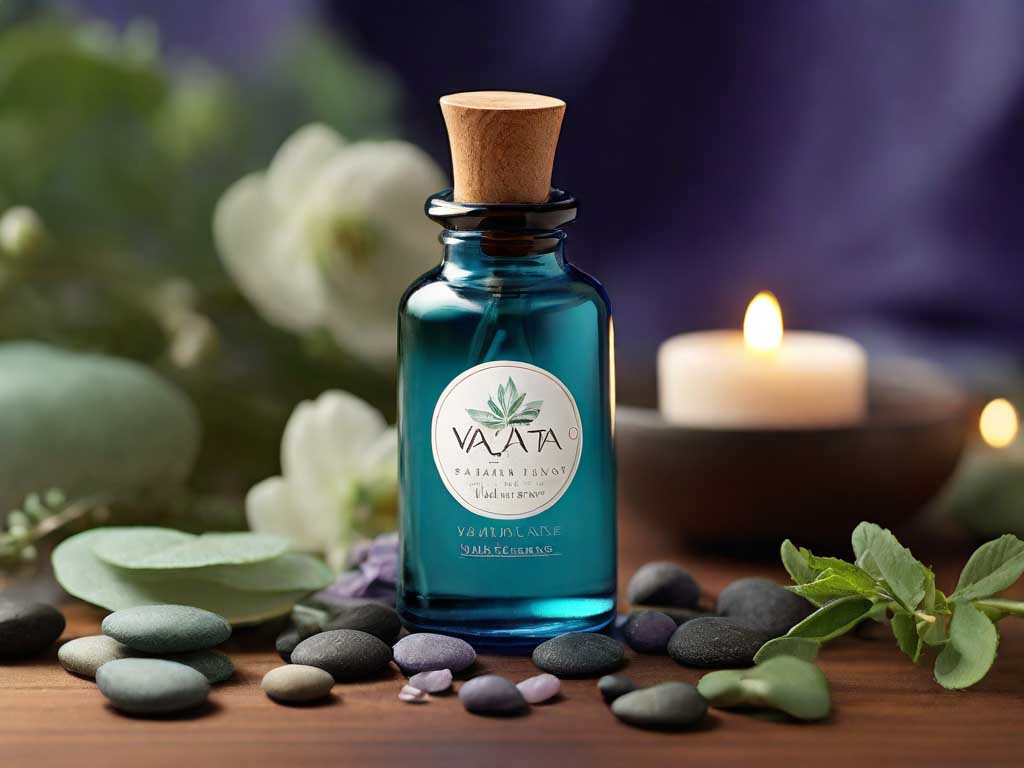
Vata Balancing Aromatherapy recipes: Techniques and Oils for Soothing the Air Element
Introduction:
In the ancient science of Ayurveda, Vata represents the air and ether elements, governing qualities of movement, creativity, and changeability. When Vata becomes imbalanced, individuals may experience feelings of anxiety, restlessness, and dryness. Aromatherapy offers a natural and effective way to restore harmony to Vata dosha, promoting a sense of calm and grounding. In this article, we’ll explore techniques and essential oil recipes for Vata balancing aromatherapy recipes to balance Vata, empowering individuals to incorporate these practices into their daily lives for holistic well-being.
Understanding Vata Imbalance:
Vata balancing aromatherapy recipes can help Vata imbalance to manifest in various ways, including insomnia, digestive issues, and anxiety. Factors such as stress, irregular routines, and environmental changes can exacerbate Vata dosha’s tendency towards imbalance. Aromatherapy provides a gentle yet potent approach to address these symptoms, offering relief and support for individuals seeking to harmonize their Vata energy.
Here are four DIY recipes for Vata balancing aromatherapy recipes
- Calming Vata Massage Oil:
- Ingredients:
- 2 tablespoons of sesame oil
- 5 drops of lavender essential oil
- 3 drops of sandalwood essential oil
- Directions:
- In a small glass bottle, combine the sesame oil with the lavender and sandalwood essential oils.
- Shake well to blend the oils thoroughly.
- Use this calming massage oil to gently massage the body before bedtime or whenever you need to relax and unwind.
- Ingredients:
- Soothing Vata Bath Blend:
- Ingredients:
- 1 cup of Epsom salt
- 5 drops of chamomile essential oil
- 3 drops of ylang-ylang essential oil
- 3 drops of bergamot essential oil
- Directions:
- In a bowl, mix the Epsom salt with the chamomile, ylang-ylang, and bergamot essential oils.
- Add the bath blend to warm running water as you fill your bathtub.
- Soak in the aromatic bath for at least 20 minutes to relax and soothe your senses.
- Ingredients:
- Vata-Balancing Room Spray:
- Ingredients:
- 2 ounces of distilled water
- 1 tablespoon of witch hazel or vodka (as an emulsifier)
- 10 drops of lavender essential oil
- 7 drops of cedarwood essential oil
- 5 drops of frankincense essential oil
- Directions:
- In a small spray bottle, combine the distilled water with the witch hazel or vodka.
- Add the lavender, cedarwood, and frankincense essential oils to the bottle.
- Shake well before each use, and spray the room to create a calming and grounding atmosphere.
- Ingredients:
- Vata-Relief Aromatherapy Roll-On:
- Ingredients:
- 1 tablespoon of jojoba oil
- 3 drops of patchouli essential oil
- 3 drops of neroli essential oil
- 2 drops of vetiver essential oil
- 1 roll-on bottle
- Directions:
- Pour the jojoba oil into the roll-on bottle.
- Add the patchouli, neroli, and vetiver essential oils to the bottle.
- Secure the roll-on cap and shake well to blend the oils.
- Apply the roll-on to pulse points such as wrists, temples, and neck whenever you need to calm and ground yourself.
- Ingredients:
These DIY recipes for Vata balancing aromatherapy recipes offer natural and effective ways to balance Vata dosha using aromatherapy techniques. Incorporate them into your daily self-care routine to promote relaxation, tranquility, and overall well-being.
Techniques for Balancing Vata with Aromatherapy:
- Abhyanga (Self-Massage): Abhyanga, or self-massage, is a traditional Ayurvedic practice that nourishes the skin, calms the nervous system, and balances Vata dosha. Incorporating aromatherapeutic oils into Abhyanga enhances its benefits, providing deep relaxation and rejuvenation. Choose warm, grounding oils such as sesame or sweet almond oil, and add a few drops of Vata-balancing essential oils such as lavender, sandalwood, or geranium.
- Aromatic Bath: Aromatic baths offer a luxurious way to unwind and soothe Vata imbalances. Create a calming bath blend by mixing Epsom salt with Vata-balancing essential oils such as chamomile, ylang-ylang, and bergamot. Allow the warm water and aromatic steam to envelop you, promoting relaxation and tranquility.
- Inhalation: Inhalation of essential oils is a quick and effective way to experience their therapeutic benefits. Diffuse Vata-balancing oils such as lavender, cedarwood, and frankincense in your home or workspace to create a calming atmosphere. Alternatively, add a few drops of essential oil to a bowl of hot water, cover your head with a towel, and inhale deeply for a few minutes to ease feelings of stress and anxiety.
- Aromatherapy Roll-On: Create your own Vata-balancing aromatherapy roll-on blend for on-the-go relaxation. Combine a carrier oil such as jojoba or fractionated coconut oil with Vata-calming essential oils like patchouli, neroli, and vetiver. Apply the roll-on to pulse points such as wrists, temples, and neck whenever you need a moment of calm and grounding.
Why Incorporate These Techniques into Daily Life?
Incorporating Vata balancing aromatherapy recipes techniques for balancing Vata into daily life offers numerous benefits for overall well-being. These practices help to calm the mind, soothe the nervous system, and promote relaxation, making them ideal for managing stress and anxiety. By integrating aromatherapy into daily self-care routines such as massage, bathing, and inhalation, individuals can cultivate a greater sense of balance, resilience, and vitality.
Conclusion:
Vata balancing aromatherapy recipes for balancing Vata with aromatherapy offers a natural and holistic approach to promoting well-being on physical, mental, and emotional levels. By incorporating techniques such as self-massage, aromatic baths, inhalation, and aromatherapy roll-ons into daily life, individuals can nurture their Vata dosha and cultivate a deeper sense of calm, grounding, and balance. Embrace the power of aromatherapy to harmonize Vata energy and enhance your journey towards optimal health and vitality.
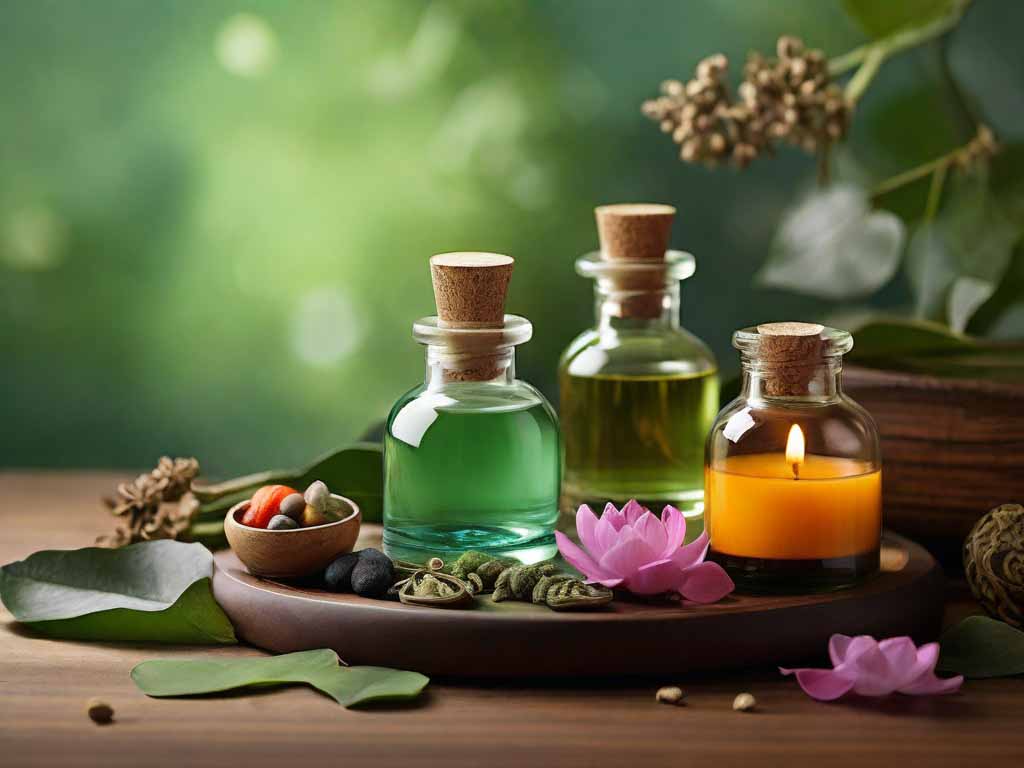
Blissful Aromatic Alchemy: 3 Ways Ayurvedic Aromatherapy Elevates Wellness
Aromatherapy, deeply rooted in Ayurvedic medicine, uses plant essences to promote balance and vitality. Essential oils and herbal infusions are tailored to individual needs, fostering physical, mental, and spiritual health. DIY recipes for holistic wellness illustrate the practice’s accessibility, while its aromatic effects honor nature’s healing potential and our intrinsic harmony with the world.
